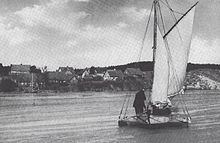Narmels
| Lost place
Narmeln
Нармельн
|
||||||||||||||||||||||||||
|
||||||||||||||||||||||||||
|
||||||||||||||||||||||||||
Narmeln (also Polski , Polsk ; Russian Нормельн Normeln ) is a no longer existing place of the Fresh Spit ( Russian Балтийская коса Baltijskaja Kossa "Baltic Spit"), Baltijsk Rajon ( Pillau district ) in the Kaliningrad Oblast ( Koenigsberg region ) in Russia . The area is located immediately east of the Polish border and was known for the 45 meter high dune .
As far as is known, Narmeln has had no civilian settlement since 1945 . The Russian part of the spit was closed to civilians until 2012.
history
Since the dissolution of the Teutonic Order, Narmeln belonged to the area of the Hanseatic City of Danzig . On December 12, 1489, the city council issued the landlord Hans Voyte a hand-held certificate for the jug in Ermelen . The colloquial name Polski was used in Narmeln from the 17th century until 1945.
After the second partition of Poland , the city of Danzig with Narmeln came to Prussia in 1793 and again to the Republic of Danzig in 1807–1814 . Since 1814 Narmeln belonged to West Prussia and in 1920 after the Versailles Peace Treaty to the district of Elbing in the administrative district of West Prussia of the province of East Prussia .
The historical border between East and West Prussia ran between Narmeln and the Narmelner dune. After the end of the Second World War , Narmeln was the only place in West Prussia that fell to the Soviet Union .
Residents
In 1910 the place had 257 inhabitants, this number rose to 294 by 1939. Nothing is known about civil settlement since 1945. Some of the buildings are now in the restricted area and are used by the military.
School and church
Until 1825 the children went to school in Alt-Neukrug, about 4 km away (since then desert ) and until 1878 in Neukrug (today: Nowa Karczma , or Piaski ), 8 km away . In 1879 the place got its own teacher and in 1895 a school house was built.
The Protestant church was in Neukrug. Services were also held in the Alt-Neukruger schoolhouse, which was threatened by sand and burned down in 1826.
traffic
In 1906 Narmeln was given a small port, but it soon silted up again. In 1908 the way over the spit was improved, the construction of a paved road did not take place until 1914.
border
The state border between Poland and the Soviet Union - later Russia - established after the Second World War , across the spit between the two bodies of water ( Baltic Sea , Fresh Lagoon ) is only about 850 m long, making it the shortest land border between Poland and Russia and the most western point in Russia.
The Russian barrier line consists of markings (border posts, prohibition signs) directly at the border, mostly covered posts, a solid, electrically secured fence 280 m and another barrier strip 1600 m away. The Russian part of the "Baltic Spit" ( "Балтийская коса" ) was a restricted area for civilians until 2012. The Russian border troops subordinate to the FSB use a remaining German house in the village and additional buildings on the southwestern outskirts of Narmeln. Due to a clerical error, the Russians call the place "Нормельн" (N o sleeves) . The command is subordinate to the Königsberg border protection department ( Russian Кёнигсбергский погранотряд Kjonigsbergski pogranotrjad - not: Kaliningrad ).
nature
Narmeln became famous for the Narmelner Dune , which, at 45 meters high, was the most impressive dune in the Fresh Spit. Houses were repeatedly buried by dune sand, around 1630. The school town of Alt-Neukrug was also buried by sand in 1825.
literature
- Josef Nikodemus Pawlowski: Popular history and description of the Gdansk district. Danzig 1885.
- Georg Mielcarczyk: Narmeln-Neukrug-Vöglers. A parish on the Fresh Spit. Bremerhaven 1971. ( East German rural communities and parishes , Volume 7)
Web links
Individual evidence
- ↑ Khutorskoy: Как я стал пограничником, или 20 лет спустя на погранзаставе . In: khutorskoy.livejournal.com. February 12, 2012, accessed on July 3, 2019 (Russian, "How I became a border guard or 20 years later at a border post").



